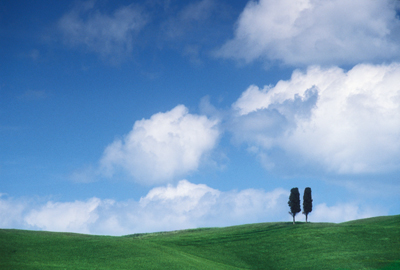Skies are relatively easy to photograph in the technical sense, but being in the right place at the right time is more difficult. The most interesting and dramatic cloud formations are generally found at times of seasonal or meteorological change; in spring and autumn, at dawn and dusk, and before and after storms. The elevation of the sun and the direction of the light are also significant because colour is very important in sky images.
 Optimum exposures for the sky and the land it illuminates are likely to differ by three or four stops. If exposure is set for the darker land the sky will be washed out. If it is set for the sky the land may be reduced to a silhouette. A compromise may be successful but might not record either element in a satisfactory manner. Polarizing filters darken the sky and increase cloud contrast and impact, but a graduated neutral density filter may be necessary to bring the two exposures into balance.
Optimum exposures for the sky and the land it illuminates are likely to differ by three or four stops. If exposure is set for the darker land the sky will be washed out. If it is set for the sky the land may be reduced to a silhouette. A compromise may be successful but might not record either element in a satisfactory manner. Polarizing filters darken the sky and increase cloud contrast and impact, but a graduated neutral density filter may be necessary to bring the two exposures into balance.
If the land is completely excluded from the composition, contrast reduces and exposure is easier to handle. Look for strands of high-altitude cirrus cloud turned pink by the rising or setting sun, or watch angry cumulus piling up into dark and threatening storms. Lenticular clouds, those with smooth lens-like outlines or wave structures, can also be very attractive because they tend to have interesting shapes and brilliant iridescent colours. They form above hills and mountains as air is forced upward by the shape of the land.
Wide-angle lenses are essential for many photographs of the sky. Indeed “large sky” images can be particularly attractive when composed to include a just a narrow strip of the horizon dwarfed by an overpowering sky. Linear cloud formations produce a radial pattern diverging to the top corners of the image. Diagonal lines are as powerful and attractive in skies as in other images, so include them whenever possible.
Various warm-coloured filters can be used to exaggerate the redness of a sunrise or sunset, but these effects should not be overused. The 81A and 81B types are perhaps the most useful for realistic images but all sorts of surreal effects can be achieved with stronger or more exotic colours.






